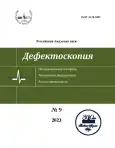Development of an empirical model for damage degree assessment of steel specimens based on the results of acoustic emission signal flow statistical processing
- Authors: Marchenkov A.Y.1, Vasiliev I.E2, Chernov D.V2, Zhgut D.A1, Pankina A.A1, Kovaleva T.Y.1, Kulikova E.A1
-
Affiliations:
- National Research University «Moscow Power Engineering Institute»
- Mechanical Engineering Research Institute of the Russian Academy of Sciences
- Issue: No 9 (2023)
- Pages: 18-26
- Section: Articles
- URL: https://journals.rcsi.science/0130-3082/article/view/141572
- DOI: https://doi.org/10.31857/S0130308223090026
- EDN: https://elibrary.ru/EAYYUE
- ID: 141572
Cite item
Full Text
Abstract
About the authors
A. Yu Marchenkov
National Research University «Moscow Power Engineering Institute»Moscow, Russia
I. E Vasiliev
Mechanical Engineering Research Institute of the Russian Academy of SciencesMoscow, Russia
D. V Chernov
Mechanical Engineering Research Institute of the Russian Academy of Sciences
Email: chernovdv@inbox.ru
Moscow, Russia
D. A Zhgut
National Research University «Moscow Power Engineering Institute»Moscow, Russia
A. A Pankina
National Research University «Moscow Power Engineering Institute»Moscow, Russia
T. Yu Kovaleva
National Research University «Moscow Power Engineering Institute»Moscow, Russia
E. A Kulikova
National Research University «Moscow Power Engineering Institute»Moscow, Russia
References
- Pollock A. Acoustic emission testing. Metals handbook / Edited by. Adrian Pollock. 9 edition. AST International. 1989. V.17. P. 278-294.
- Иванов В.И., Барат В.А. Акустико-эмиссионная диагностика. М.: "Спектр", 2017. 368 с.
- Makhutov N.A., Ivanov V.I., Sokolova A.G., Vasil'ev I.E., Chernov D.V., Skvortsov D.F., Bubnov M.A. Monitoring composite fiber failure using acoustic emission system, vibration analyzer, and high-speed video recording // Russ. J. Nondestr. Test. 2020. V. 56. No. 12. P. 960-970.
- Makhutov N.A., Matvienko Y.G., Vasil'ev I.E., Chernov D.V., Ivanov V.I.Rupture tests of reinforcing fibers and a unidirectional laminate using acoustic emissions // Instruments and Experimental Techniques. 2022. Т. 65. № 2. С. 305-313.
- Matvienko Y.G., Vasil'ev I.E., Chernov D.V. Damage and failure of unidirectional laminate by acoustic emission combined with video recording // Acta Mechanica. 2021.
- Makhutov N.A., Vasiliev I.E., Chernov D.V., Ivanov V.I., Terent'ev E.V. Adaptation of Methodology for Monitoring Damage Kinetics and Assessing Load-Bearing Capacity in Relation to Steel Products // Russian Journal of Nondestructive Testing. 2022. V. 58. No. 9. P. 800-813. doi: 10.1134/S1061830922090078
- Lukonge A., Cao X. Leak detection system for long-distance onshore and offshore gas pipeline using acoustic emission technology. A review // Trans. Indian Inst. Met. 2020. V. 73. P. 1715-1727.
- Acoustic emission monitoring of corrosion in steel pipes using Lamb-type helical waves. https://doi.org/10.1177/14759217221105644
- Shehadeh M., Osman A., Elbatran A.A., Steel J., Reuben R. Experimental Investigation Using Acoustic Emission Technique for Quasi-Static Cracks in Steel Pipes // Assessment. Machines. 2021. V. 9. P. 73. https://doi.org/10.3390/machines9040073
- Louda P., Sharko A., Stepanchikov D. An Acoustic Emission Method for Assessing the Degree of Degradation of Mechanical Properties and Residual Life of Metal Structures under Complex Dynamic Deformation Stresses // Materials. 2021. V. 14. P. 2090.
- Uhlmann E., Holznagel T., Clemens R. Practical Approaches for Acoustic Emission Attenuation Modelling to Enable the Process Monitoring of CFRP Machining //j. Manuf. Mater. Process. 2022. No. 6. P. 118. https://doi.org/10.3390/jmmp6050118
- Li P., Zhang W., Ye Z., Wang Y., Yang S., Wang L. Analysis of Acoustic Emission Energy from Reinforced Concrete Sewage Pipeline under Full-Scale Loading Test // Appl. Sci. 2022. V. 12. P. 8624. https://doi.org/10.3390/app12178624
- Работнов Ю.Н. Ползучесть элементов конструкций. М.: Наука, 2014. 752 с.
- Москвичев В.В., Махутов Н.А., Шокин Ю.И., Лепихин А.М., Анискович Е.В., Буров А.Е., Гаденин М.М., Готовко С.А., Доронин С.В., Кашубский Н.И., Москвичев Е.В., Москвичева Л.Ф., Рейзмунт Е.М., Суходоева Н.В., Федорова Е.Н., Филиппова Ю.Ф., Чабан Е.А., Черняев А.П., Чернякова Н.А. Прикладные задачи конструкционной прочности и механики разрушения технических систем. Новосибирск: Наука, 2021. 796 с.
- Заводчинская Э.Б. Общие закономерности и критерии разрушения твердых тел на разных масштабных уровнях при длительном нагружении (Обобщающая статья) // Заводская лаборатория. Диагностика материалов. 2022. № 7. С. 48-62. https://doi.org/10.26896/1028-6861-2022-88-7-48-62
- Рыбин В.В. Большие пластические деформации и разрушение металлов. М.: Металлургия, 1986. 224с.
- Панин В.Е., Лихачев В.А., Гриняев Ю.В. Субструктурные уровни деформации твердых тел. Новосибирск: Наука, 1985. 226 с.
- Сарафанов Г.Ф., Перевезенцев В.Н. Закономерности деформационного измельчения структуры металлов и сплавов. Нижний Новгород: "Новые многофункциональные материалы и нанотехнологии", 2007. 96 с.
- Tyutin M.R., Botvina L.R., Levin V.P., Beletskii E.N., Sinev I.O., Petersen T.B. Kinetics of damage accumulation in a D16CH alloy during static loading // Russian Metallurgy (Metally). 2022. V. 2022. No. 4. P. 444-451.
- Лагутин М.Б. Наглядная математическая статистика. М.: Бином. Лаборатория знаний, 2009.472 с.
- Большев Л.Н., Смирнов Н.В. Таблицы математической статистики. М.: Наука, 1983. 416 с.
Supplementary files









